
JSTAMP Functions
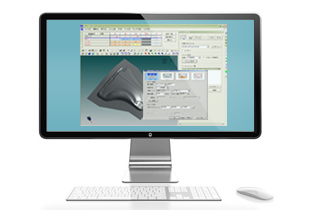
Address various tasks in tool shop
JSTAMP represents the Sheet metal forming process virtually by numerical simulation. Users can examine the simulation result, output it to CAD, and directly use the CAD as a countermeasure by using JSTAMP.
Designers can avoid the challenges of trial and error. JSTAMP provides an adequate result and reduces the lead time and cost of tool design.
JSTAMP provides comprehensive support throughout the design process from the first trial to the final stage. The feature for addressing complicated process stages, low formability materials, and latest technologies covers various tasks in the Sheet metal forming process.
Major functions
Improve QCD (Quality, Cost, Delivery)
-
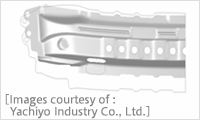
- Blank line development
- JSTAMP estimates blank line development based on product geometry within several tens of seconds. Given a product geometry, quick and convenient calculations improve the yield potential of press products. Accuracy can be further improved after detailed simulation by comparing the error with the product by using the auto prediction feature.
-
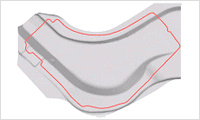
- Trim line development
- This feature maps the product geometry on the tool surface. JSTAMP predicts the trim line based on the product and the tool geometries within several minutes. Accuracy can be further improved after a detailed simulation by comparing the error with the product by using the auto prediction feature.
Realistic reproduction of forming process and its evaluation
-
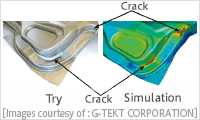
- Accurate evaluation of crack and wrinkle
- Leading-edge FEM technologies describe crack and wrinkle accurateluy. Parallel processing can deal with several tens of thousands of meshes, which are needed for accurate simulation.
-
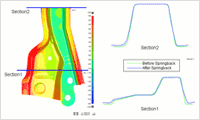
- Precise springback analysis
- JSTAMP includes a precise springback simulation module with "Yoshida-Uemori model" and "Yoshida's 6th-order yield function". JSTAMP simulation can consider the Bauschinger effect, the SD effect, rate sensitivity and plastic strain dependency of the unloading Young's modulus so that JSTAMP can deal with high-strength steel and alminum alloys.
-
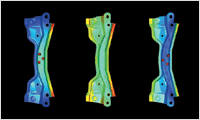
- Geometry evaluation of springback
- Users can use precise geometries computed with various methods for geometry evaluation. JSTAMP measures and evaluates 3-dimension springback amount uniformly, regardless of the constraint conditions. It also has a range of positioning features (best-fit, three-point constraint, and triaxial constraint) and measurement features (cross-section angel, circular radius, and shape deviation).
-
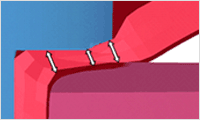
- Ironingdeep drawing simulation
- By using solid elements in the forming simulation, JSTAMP allows users to evaluate deformations during ironing, oining, burring, bending thick sheet, and ultraprecision Sheet metal forming, which shell elements cannot deal with.
-
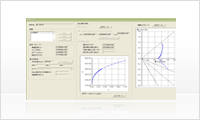
- Material database
- JSTAMP includes a material database that covers more than 100 types of materials such as steels (hightensile materials), SUS, and aluminum alloy materials as standard. Users can start a simulation straightaway. The user-defined material database can be added. The data of the Yoshida-Uemori material model for precise springback simulation is available as a paid tool.
Virtual evaluation of countermeasures
-
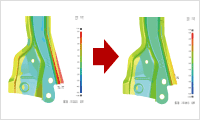
- CAD output of SB-compensated tool
- Simulated compensated tool can be output to CAD. The output to CAD is used directly in CAM to pass the evaluated result to the following process.
-
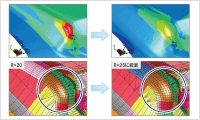
- Expansion of tool radius and CAD output
- Users can modify the fillet R parametrically without going back to the CAD data. JSTAMP provides the opportunity to visualize cracks and shocklines quickly and easily. The modified idea can be output into the IGES format, which can be mapped to the original CAD data.
Manufacturing trends
-
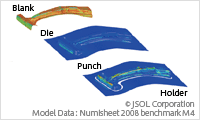
- Hot stamping
- Hot stamping is a forming method that has less springback: preheat a sheet material up to austenite temperature first, then perform hot forming, and follow it with tempering and rapid cooling to obtain a high-strength sheet panel. JSTAMP can consider the temperature dependency of a material and the heat transferred to the tool by using thermal - structural interaction analysis.
-
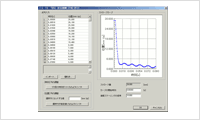
- Overview of Servo Press Analysis Functions
- JSTAMP has a feature to deal with flexible servo press motions. A new feature to describe dynamics during servo pressing with irregular sliding motion (e.g., a formability improvement due to the relubrication effect) with CAE is under development.
-
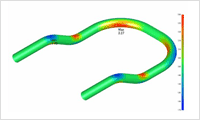
- Tube hydroforming
- Tube hydroforming is a forming method in which a straight tube is bent ("bending") and preformed before it is processed by applying internal hydraulic pressure to the tube and simultaneously pressing both ends of the tube along the axial direction. JSTAMP has a self-developed simulation solver to facilitate fast computation of the bending process without any tool data.
Better operability and better work efficiency
-
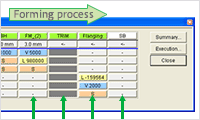
- Multi-stage simulation
- User-friendly interface navigates the multi-staged forming process simulation.
-
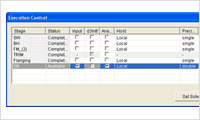
- User-friendly execution control
- JSTAMP is flexible in terms of the computer platform on which to run a simulation. Users can operate JSTAMP on their own PC and run a simulation on the machine they choose?from a PC to clustered massively parallel Linux computers. Consecutive multiple-stage simulations can be run automatically.
-
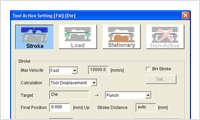
- Various tool actions
- Users can setup complicated tool motions such as pad pressure and bottoming or cam motion easily and correctly.
-
- Support for repeated simulation
- Users can repeat a calculation quickly and easily to determine countermeasures. Poor formability can be addressed not only by adjusting numerical parameters but also by positioning or resizing the blank. Users can edit the model when evaluating the simulation result. JSTAMP provides multiple user-friendly features, including a list of design change items.
-
- Project template
- Users can save time and avoid human error by saving typical process layouts (tool structure and motion) and simulation parameters in a template and reusing the template.
-
- SmartPost File Output
- There is a feature to output the simulation result of JSTAMP in the "3D viewer SmartPost"*1 file format. What is SmartPost?
- *1 JSOL supplies SmartPost (incl. Plugin) based on the technical provision of Ceetron AS, Norway.
Features
- +All Open
- -All Close
- +Evaluation of analysis results
-
- - Cracking and Wrinkle prediction
- Sheet thickness, Thinning distribution
- Strain distribution
- Display forming limit diagram, Stress curve (FLD, FLSC), history
- Drawing circle grids
- Display curvature
- - Forming load (Working pressure, Cushion pressure) prediction
- - Display tool pressure, Contact area
- - Material fitting
- - Amount of material inflow, Inflow direction, Tracing
- Material stretching
- - Shock line, Gap
- - Blank line development, Trim line development
- - Cross-section evaluation
- Geometry measurement
- Thickness distribution on a deformed cross-section
- - Reflect display
- - Animation output (AVI, MWV)
- - Automatic report generation
- - SmartPost (post viewer) output (JSOL provides SmartPost free of charge)*
- - Evaluation of measurement by clamp simulation
- - Surface defect evaluation (simulate oil stone inspection)
- - Cracking and Wrinkle prediction
- +Accurate springback prediction
-
- - Fully integrated shell element
- - Y-U kinematic hardening model (standard feature, material DB is available as an additional paid option)*
- - Higher-order yield functions such as Yoshida 6th-order and Yld2000-2d
- +Accurate crack prediction
-
- - Ductile failure evaluation (Cockcroft-Latham, Oyane, etc)
- - FLC evaluation based on experimental or theoretical data
- +High -speed computation and memory distribution
-
- - Adaptive remeshing and coarsening
- - Parallel computation (MPP, SMP), Implicit MPP
- +Shape Deviation evaluation*
-
- - Comparative verification between a springback simulation result and the product CAD
- - Comparative verification between panel measurement data and the product CAD
- - Contour of geometry gap, Comparison of cross-section
- - Positioning (Inspecting standard, Best-fit, etc)
- +Simulation with solid elements (sheet materials)
-
- - High-precision simulation for ironing, Coining, Burring
- - Thickness, Thickness reduction evaluation
- +Simulation support features
-
- - Automated successive simulation run for a multi-stage high-precision simulation
- Gravity loading, Forming, Drawing, Trimming, Bending
- Springback
- - User-defined process template creation
- - Die actions
- Single/Double/Triple actions, Four-piece
- Drawing, Forming, Cum, Restriking, Trimming/Piercing
- Forming pressure control
- Rotary tool
- - Material models (Anisotropic plasticity, Anisotropic yield function, Bauschinger effect, Strain rate dependency, etc)
- - Material database (over 300 materials)
- - Tailored blank
- - Accurate tool mesh
- - Tool mesh lumping modification
- - Fine trim mesh
- - Half model and quarter model simulation
- - EQ (equivalent) drawbead
- - Automated successive simulation run for a multi-stage high-precision simulation
- +Try-out support
-
- - Re-analysis
- - Fillet radius expansion
- - Springback-compensated tool creation*
- Compensated CAD surface output (IGES, STEP format)
- Compensation using scanned data of a trial panel
- -Line auto prediction: blank line development and trim line
- +HYSTAMP (one-step inverse analysis solver)
-
- - Formability evaluation in product design phase
- - Initial tool design support
- - Blank line development
- - Trim line development (flange development)*
- - Drawbead/Pad pressure
- +Hydroforming/flow forming
-
- - Tube hydroforming*
- - Sheet hydroforming (Hydraulic Counter-pressure Forming)
- -Tool Deflection analysis support*
- +Hot forming (thermal-structural interaction analysis)
-
- - Quenching evaluation, Hardness evaluation, CCT curve diagram
- - Tool cooling analysis (capable of multishot)
- - Patchwork simulation
- +CAD interface
-
- - Supported format
- - CAD data auto healing (spGateAuto)
- IGES, JAMA-IS
- CATIA V4/V5*
- - * Marked features are available as additional paid options.
- - Terms and conditions may be changed or updated at any time without prior notice. For details, please contact our sales staff.
Supported platforms
| OS |
|
|---|---|
| CPU | Intel Core i7, Xeon |
| Memory | 16 GB or above is recommended to run the program (depending on the requirements of the given simulation) |
| Hard disk |
|
| Display resolution | 1,280 x 1,024 or higher |
| Graphic card |
|
| Network card | Required for licensing |
- - The automatic report generation function requires Microsoft PowerPoint. Compatible PowerPoint versions are 2007, 2010 (32-bit version only), and 2013 (32- and 64-bit versions).
- *Product names and service names are the trademarks or the registered trademarks of their proprietors.




